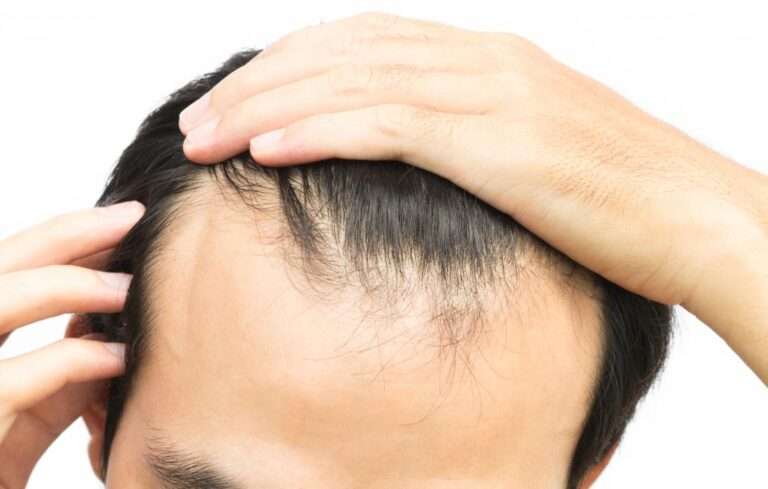Hair Loss and Having an Uneven Hairline - Am I Going Bald?
It’s important to note that an uneven hairline is not the same as a receding hairline or a widow’s peak. A receding hairline is characterized by hair loss at the temples, while a widow’s peak is a V-shaped point in the center of the hairline.
The causes of an uneven hairline can vary, but some common ones include genetics, traction alopecia, and male pattern baldness. Genetics can play a role in hair loss and can be inherited from family members. Traction alopecia is caused by repeatedly pulling on the hair, often from over-styling or wearing tight hairstyles. Male pattern baldness, characterized by a receding hairline and thinning crown, is also a possible cause.
If you are concerned about your hairline, it’s best to consult a hair loss specialist for a proper diagnosis and treatment options. They may recommend a hair loss treatment, such as minoxidil or finasteride, or suggest lifestyle changes to prevent further hair loss.
It’s important to remember that hair loss can be a natural part of the aging process and having an uneven hairline is common and not something to be worried about.
Discover the underlying causes of an uneven hairline, including which are treatable and which may lead to hair loss or baldness in the future.
What is an uneven hairline?
An uneven hairline refers to a hairline that is not symmetrical and appears to be receded on one side. The causes of an uneven hairline can vary, including genetics, traction alopecia, or male pattern baldness. Some people may have an uneven hairline from birth, while others may develop it over time.
It is important to distinguish an uneven hairline from other hair conditions. A receding hairline at both temples at different rates is not an uneven hairline, but rather a symptom of male pattern baldness. Additionally, a widow’s peak is a V-shaped point in the center of the hairline and not an uneven hairline.
Is is abnormal having an uneven hairline?
Why is my hairline uneven?
There are several reasons why a person may have an uneven hairline. It can be a natural occurrence and not all people have perfectly symmetrical hairlines. Some common causes of an uneven hairline include genetics, if receding hairlines run in the family, traction alopecia from over-styling or tight hairstyles, and male pattern baldness.
Genetics
If you suspect genetics may be a factor in your uneven hairline, it may be helpful to look at the hair patterns of older members of your family. Observing any receding hairlines in your relatives can give you an idea of what to expect for your own hair growth and potential for hair loss.
Hair loss can be hereditary and if your father is bald it is possible that you may also experience hair loss. However, it is important to note that genetics can also result in a receding hairline without leading to complete baldness. Some individuals may develop a mature hairline or experience hair loss to varying degrees. It’s important to note that it is not always a cause for alarm and there are treatments options available like scalp micropigmentation.
Traction Alopecia
Traction alopecia is a hair condition caused by repeatedly pulling on the hair, often from over-styling or wearing tight hairstyles. This can include hairstyles such as tight ponytails or buns. Using chemicals or heat to style the hair can also worsen traction alopecia by weakening the hair, causing it to break and fall out more easily. This can result in an uneven hairline as it is unusual for the hair loss to happen completely evenly on both sides.
Male Pattern Baldness
Male pattern baldness is caused by the hormone dihydrotestosterone (DHT), which is created when the testes process testosterone in men. This condition can often result in an uneven hairline as it is unusual for DHT to affect the hairline symmetrically on both sides. It is more common for hair loss to occur in a non-uniform pattern, which can manifest as an uneven hairline.
Are you balding if you have an uneven hairline?
Having an uneven hairline does not necessarily mean that a person will experience complete baldness. While certain causes of an uneven hairline, such as male pattern baldness, may be related to hair loss, other factors such as genetics or traction alopecia may not necessarily lead to significant hair loss. It is important to consult with a hair specialist to determine the underlying cause of an uneven hairline and the potential for future hair loss.
An uneven hairline can also be a sign of a mature hairline, which is a natural process that occurs in young adults. Younger men and women typically have a solid hairline with closed corners, but as they age, the hairline may elevate and begin to thin at the temples. This does not necessarily mean that they will continue to recede or go fully bald. Many people experience receding hairlines without visible thinning, and in these cases, the hairline may stop receding and remain as it is.
Where there is thinning of hair follicles across the entire top of the head, male pattern baldness is the likely cause. This is caused by the effects of dihydrotestosterone (DHT) on hair follicles, which shrinks the hair follicles and causes hair to thin. DHT is a hormone that is created when the testes process testosterone, which starts during puberty.
How do I know if I'm going bald?
Can I fix my uneven hairline?
There are several options available to address an uneven hairline. Some hairstyles can be used to conceal it, while more invasive options include hair transplants or scalp micropigmentation (a treatment that mimics the appearance of hair through tattooing). Medications such as Minoxidil and Finasteride may also be effective if the uneven hairline is caused by hair loss. It’s important to consult a hair specialist to understand the cause of your uneven hairline and which approach would be the most effective for you.
SMP
If your uneven hairline is caused by male pattern baldness, there are a few options to address it. One option is a hair transplant, where hair follicles are taken from one area of the scalp and transplanted to the areas of hair loss. Minoxidil and Finasteride are also treatments that can help slow down hair loss and potentially regrow hair. Scalp micropigmentation, or SMP, is another option where the appearance of a full head of hair is created by tattooing the scalp. Keep in mind, SMP is a more drastic option and requires shaving your head. It is important to consult a hair specialist to determine the best course of treatment for you.
Hair Transplant
If you’re experiencing an uneven hairline and are concerned about potential hair loss, a hair transplant may be an option. However, it’s important to note that this is a more drastic solution and should be considered carefully, especially if you’re young and your hairline may change in the future. Techniques such as FUT or FUE can be used to treat an uneven hairline, but it’s important to keep in mind that there is a risk of further receding in the future.
Minoxidil
Minoxidil, the active ingredient found in hair loss treatment Rogaine, can be used to treat hair loss caused by various factors. It is applied in the form of drops or foam, massaged into the scalp with the fingertips. If your uneven hairline is a result of previous hair loss, Minoxidil may be a viable option. Although not guaranteed, studies have shown that it is effective in the majority of cases, with 94% of test patients reporting positive results.
Finasteride
If your uneven hairline is the result of hair loss, Finasteride may be an effective treatment option. Studies have shown that the medication, which works by reducing the production of the hormone dihydrotestosterone (DHT), can lead to regrowth of hair in a significant percentage of patients. One study found that 66% of men experienced some regrowth of hair after two years of continuously taking Finasteride. Another study concluded that Minoxidil had been at least ‘moderately’ effective in 84.3% of patients.
Can I hide my uneven hairline?
Can I be born with an uneven hairline?
Can an uneven hairline grow back?
Summary - If I have an uneven hairline will I go bald?
If you’re concerned about an uneven hairline, it’s important to first understand that it is a common occurrence and not necessarily a cause for alarm. However, it’s important to determine the cause of the uneven hairline to understand the potential outcomes. Some causes, such as genetics or traction alopecia, are natural and may not lead to further hair loss. Others, such as male pattern baldness, may indicate future hair loss. There are various treatment options available, such as hairstyles, hair transplants, scalp micropigmentation, Minoxidil, and Finasteride. It’s important to seek professional advice and take control of the situation instead of ignoring it.
Losing hair can be an emotional experience, so it’s important to make the best decision for yourself when it comes to managing it. If you’re considering shaving your head, consider reading a guide on determining the right time to do so.


